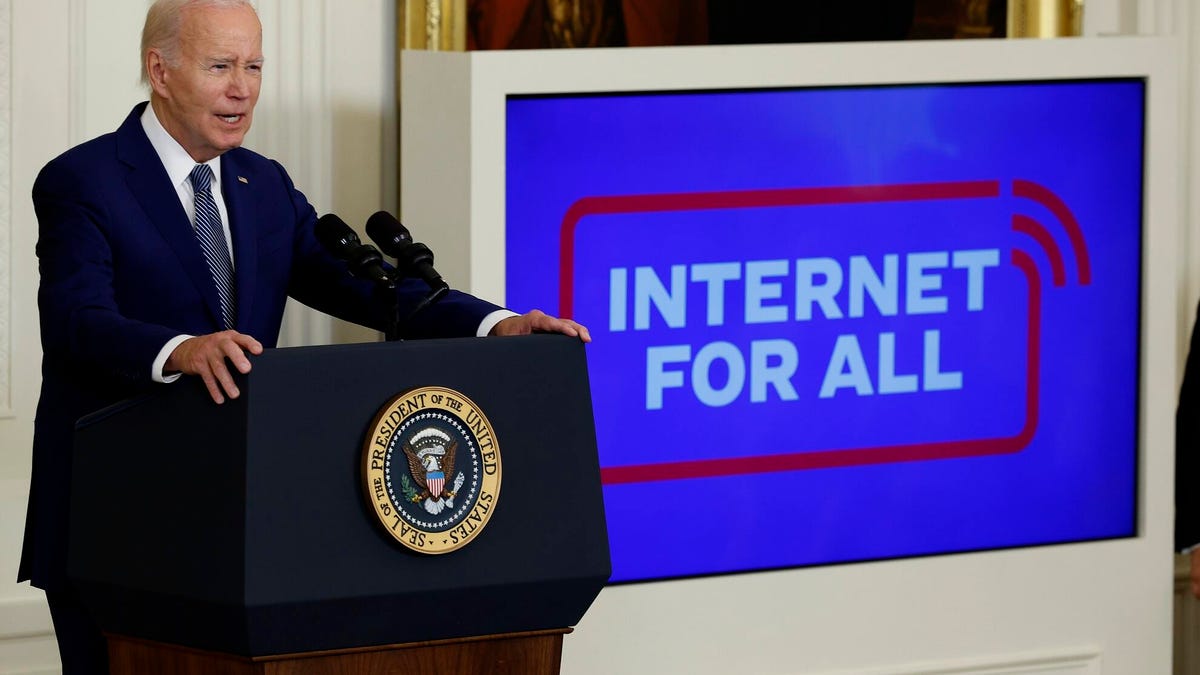 Why You Can Trust CNET
Why You Can Trust CNET Broadband Expansion Gets $42 Billion From White House
The funding is part of the $1.2 trillion Infrastructure Act.

US President Joe Biden announces that more than $42 billion will go toward expanding access to high-speed internet.
President Joe Biden said Monday that over $42 billion in aid will be spread across the United States to expand broadband access.
As part of the Biden administration's goal to connect everyone to "reliable, affordable high-speed internet by the end of the decade," the Broadband Equity Access and Deployment, or BEAD, program will allocate the funding among the states, territories and Washington, DC, according to a press release.
At a minimum, territories will get $27 million and states $107 million, up to a maximum of $3.3 billion. Each award is listed in a separate press release. "Put simply, high-speed internet is a necessity in today's society," said Mitch Landrieu, White House infrastructure coordinator and senior adviser to the president.
Locating local internet providers
The administration noted that 8.5 million households and small businesses are located in areas without access to high-speed internet, which is around how many are listed on the Federal Communications Commission's new maps showing connectivity gaps around the US. The FCC released its first versions of the revamped maps in November, which swapped out the large census blocks used in previous versions to drill down to show whether 114 million individual homes and businesses actually have connectivity.
Read more: Home Internet Cheat Sheet: Cheap Plans, Top Providers and Much More
Locating local internet providers
The $42 billion in funding to deploy high-speed internet in areas without it comes from the $1.2 trillion Infrastructure Act signed into law in November.
In areas where broadband service is already available, an additional $14.2 billion from the Infrastructure Act is planned to support the Affordable Connectivity Program, a $30-a-month subsidy to make high-speed internet more affordable for low-income people. Other assorted funds include $2.75 billion for digital equity and inclusion efforts, which could help end digital redlining that's kept ISPs from servicing low-income areas with fast internet, as well as $2 billion for Indigenous governments and organizations and $2 billion in grants and loans to build internet infrastructure in rural areas.
When will you get faster internet under BEAD?
The BEAD program provides funds for states and territories to connect areas that don't have high-speed broadband internet, so if your area does have broadband, these funds won't improve your connectivity. Each state and territory has been awarded different amounts, from a low of $27 million for the US Virgin Islands to a high of $3.3 billion for Texas.
A handful of states have publicized draft plans for how they'll use these BEAD funds, which have been collected by the National Telecommunications and Information Administration. Where available, these plans have been linked next to the state or territory's award amount.
- Alabama: $1,401,221,901.77
- Alaska: $1,017,139,672.42
- Arizona: $993,112,231.37
- Arkansas: $1,024,303,993.86
- California: $1,864,136,508.93
- Colorado: $826,522,650.41
- Connecticut: $144,180,792.71
- Delaware: $107,748,384.66
- District of Columbia: $100,694,786.93
- Florida: $1,169,947,392.70
- Georgia: $1,307,214,371.30
- Hawaii: $149,484,493.57 (BEAD Five-Year Action Plan)
- Idaho: $583,256,249.88
- Illinois: $1,040,420,751.50
- Indiana: $868,109,929.79
- Iowa: $415,331,313.00
- Kansas: $451,725,998.15
- Kentucky: $1,086,172,536.86
- Louisiana: $1,355,554,552.94 (BEAD Initial Proposal)
- Maine: $271,977,723.07 (BEAD Five-Year Action Plan)
- Maryland: $267,738,400.71
- Massachusetts: $147,422,464.39
- Michigan: $1,559,362,479.29
- Minnesota: $651,839,368.20
- Mississippi: $1,203,561,563.05
- Missouri: $1,736,302,708.39
- Montana: $628,973,798.59 (BEAD Five-Year Action Plan)
- Nebraska: $405,281,070.41
- Nevada: $416,666,229.74
- New Hampshire: $196,560,278.97
- New Jersey: $263,689,548.65
- New Mexico: $675,372,311.86
- New York: $664,618,251.49
- North Carolina: $1,532,999,481.15
- North Dakota: $130,162,815.12
- Ohio: $793,688,107.63 (BEAD Five-Year Action Plan)
- Oklahoma: $797,435,691.25
- Oregon: $688,914,932.17
- Pennsylvania: $1,161,778,272.41
- Rhode Island: $108,718,820.75
- South Carolina: $551,535,983.05
- South Dakota: $207,227,523.92
- Tennessee: $813,319,680.22
- Texas: $3,312,616,455.45
- Utah: $317,399,741.54 (BEAD Five-Year Action Plan)
- Vermont: $228,913,019.08
- Virginia: $1,481,489,572.87 (BEAD Initial Proposal)
- Washington: $1,227,742,066.30
- West Virginia: $1,210,800,969.85
- Wisconsin: $1,055,823,573.71
- Wyoming: $347,877,921.27
- American Samoa: $37,564,827.53
- Guam: $156,831,733.59
- Northern Mariana Islands: $80,796,709.02
- Puerto Rico: $334,614,151.70
- U.S. Virgin Islands: $27,103,240.86
For more about broadband services, here are CNET's lists of the best high-speed internet providers of 2023, the best internet providers for streaming and the best cheap internet providers, as well as a guide on how to switch broadband providers.